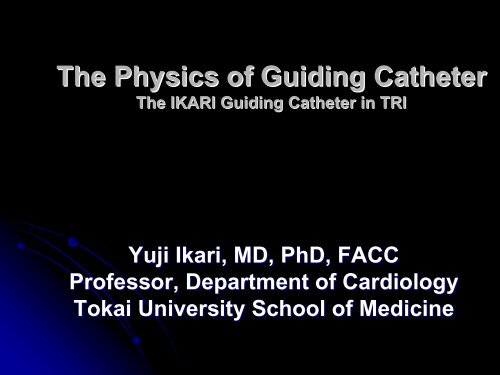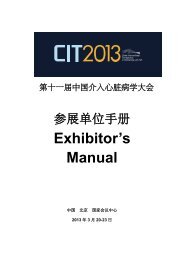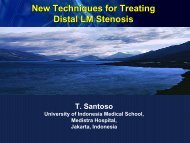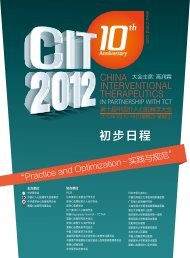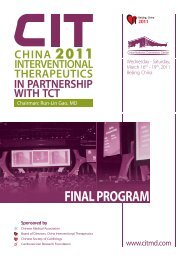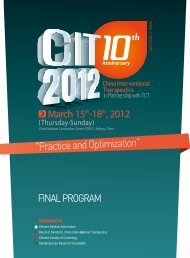The Physics of Guiding Catheter
The Physics of Guiding Catheter
The Physics of Guiding Catheter
- No tags were found...
Create successful ePaper yourself
Turn your PDF publications into a flip-book with our unique Google optimized e-Paper software.
<strong>The</strong> <strong>Physics</strong> <strong>of</strong> <strong>Guiding</strong> <strong>Catheter</strong><strong>The</strong> IKARI <strong>Guiding</strong> <strong>Catheter</strong> in TRIYuji Ikari, MD, PhD, FACCPr<strong>of</strong>essor, Department <strong>of</strong> CardiologyTokai University School <strong>of</strong> Medicine
Radial Artery is SafeBrachial arteryRight forearm (below-elbow) angiographyUlnar arteryRadial arteryradial arteryradial nervecross-section <strong>of</strong> right wristmedian nerveulnar arteryradius ulnaulnar nerve★Occlusion is not a problem.★Less neurological problems★Less bleeding complications
Benefit <strong>of</strong> TRI• Lower bleeding complication rate• Shorter rest time• Less lumbar pain• Less neurologic complication• Shorter hosipital stay• Reduction in work <strong>of</strong> co-medical medical staffs• Better QOL
Difficulty in TRI• Puncture <strong>of</strong> radial artery due to small size• Low backup force <strong>of</strong> guide catheterSome doctors would say“Low backup force is a critical problem <strong>of</strong> TRI!Choose femoral approach!!”No! It is not true.<strong>The</strong>y do not know PHYSICS.
<strong>Physics</strong> <strong>of</strong> guiding catheter ?• No textbook chapter• No published paper
History <strong>of</strong> Dr. Ikari as a radialist• In 1991, Dr Ikari started PCI• Many patients complained about lumbar pain.• In 1993-4,• First attempt <strong>of</strong> PCI via upper limb.• Dr Ikari found difficulty in guide catheters• In 1994, Palmaz-Schatz stent was approved inJapan• In 1995-6, , Dr Ikari tried to make a new catheterto overcome the weak backup force in TRI.• In 1996, Ikari-L L was completed.• In 1996, the first human case was successful.
Anatomy
Judkins typeIkari LeftPrototypes
First in Man in 1996Severe rheumatoid arthritisShe was impossible to lie in the supine position due to extremedeformity <strong>of</strong> hip and knee joints.She had anginal attack at rest.
Sales <strong>of</strong> Ikari guiding catheters25000200001500010000500007,15110,6203,2082,39910,0828,30886 5,272 6,37764 7792,2122001 2002 2003 2004 2005 2006 2007InternationalDomestic
Ikari L (IL)
Ikari-L L catheterJudkins Judkins Ikari
Ikari LBrachiocephalicangle
Consideration aboutbrachiocephalic angleABBrachiocephalic angle does not relate withbackup force.<strong>The</strong> angle makes it easier to engage.resistance (gram force)80706050403020100n.s.JL3.5 JL3.5 with angleJL3.5JL3.5 with angle
IL IFLRight upper limb approachLeft upper limb approachFemoral approach
IFL4.0 JL4.020mm35mm40mm10mm10mmIFL4.0JL4.0
Ikari L4 in TRI vs. Judkins L4 in TFIθiθf
<strong>Physics</strong> <strong>of</strong> backup force <strong>of</strong>guide catheters in TRI and TFIIkari Y, et al.J Invasive Cardiol 2005; 17:636-41
Hypothesis; physics <strong>of</strong> backup force• Fcosθ = fcosθ’ + λθ’ θλ• fcosθ ’ + λFmax = ―――――cosθMaximum backup force isacheved ifθ=90degree; θ’= 0degree; orλ is large.Ikari et al. J Invasive Cardiol 2005 ;17:636-41
R5540R6520°R50C110A3010°R45402040R304070DB2030°φ3020
Judkins L can generate greaterbackup force in TFI than in TRI.AB70θrθfresistance (gram force)605040302010P
Judkins L 3.5 can generate greaterbackup force in TRI than JL4.θ4 θ 3.50resistance (gram force)5045403530252015105P
Deep engage increase backupforce in Judkins Lθ4θ4deepresistance(gram force)605040302010P
Consideration about the static frictionresistance(gram force)9080706050403020100P
JL and IL in TRIresistance (gram force)100806040200JL4P
ComparisonVODA JudkinsIkari-FIkari
Aresistance (gram force)10090807060504030C20100E****B C DJL4 JL4deep BL3.5 IL4 IL4powerθjθ4deepθbθiθip
Size <strong>of</strong> guide catheter is one <strong>of</strong> thedeterminants <strong>of</strong> backup forceresistance (gram force)160140120100806040200*6Fr 7Fr 8Fr*Judkins in TFI
Summary <strong>of</strong> <strong>Physics</strong>• Backup force <strong>of</strong> guide catheter does notdepend on approach site but on - - -• Size <strong>of</strong> guide catheter (f)• <strong>Catheter</strong> shape• Angle between the catheter and the reverse side <strong>of</strong>the aorta (θ(and θ’)• Attachment area on the reverse size <strong>of</strong> the aorta(λ)fcosθ ’+λFmax = ―――――cosθ
Which is better, Judkins in TFI orIkari in TRI?TRI > TFIIt used to be true thatbackup force in TFIwas stronger than TRIbefore invention <strong>of</strong>Ikari catheter.θiθf
Ikari in TRI vs. Judkins in TFI14012010080606 Fr7 Fr8 Fr40200IL in TRI IFL in TFI Judkins L in TFI
In Conclusion• Backup force is determined by physics notby approach site.• Thus, TRI is always better than TFI if youuse 6 Fr guiding.• <strong>The</strong> basic study <strong>of</strong> guiding cath maycontribute to slender PCI using 5 Fr, 4 Fror 3 Fr system.


